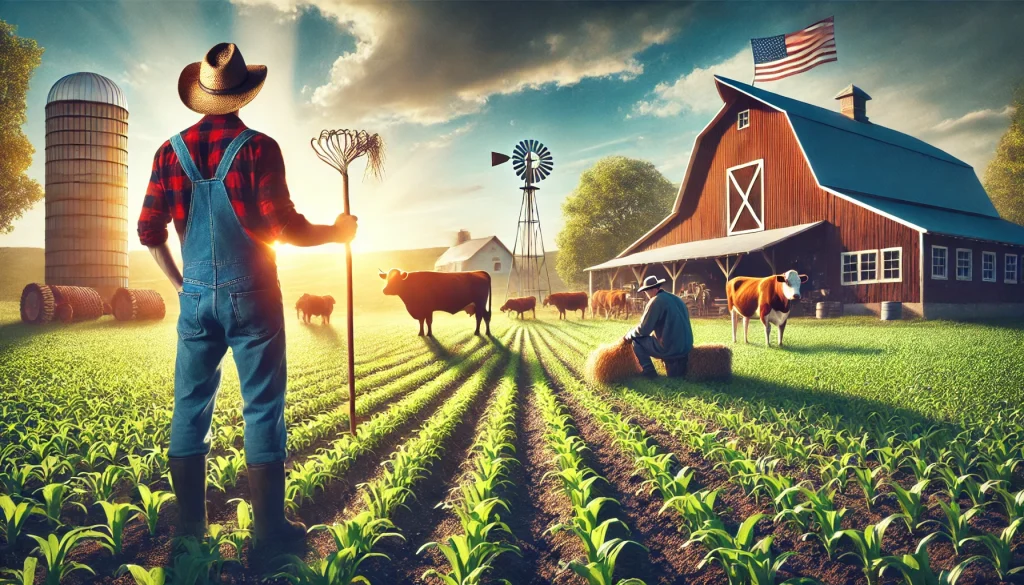American Farmers and Ranchers
The backbone of America’s food supply and agricultural economy lies in the hands of American farmers and ranchers. These hardworking individuals ensure the country’s access to fresh produce, dairy, and meat while fostering a sustainable environment. Their dedication shapes not just our dining tables but also the very fabric of rural communities across the nation. In this article, we delve into the importance, challenges, and future of American farming and ranching, exploring their impact on every aspect of American life.
The Importance of American Farmers and Ranchers
Farming and ranching have always been integral to America’s development, economy, and identity. From the early pioneers cultivating crops to today’s technologically advanced operations, the role of farmers and ranchers has evolved significantly, yet their importance remains undiminished.
1. Food Security: American farmers and ranchers provide the majority of the nation’s food supply. They cultivate crops like wheat, corn, and soybeans while raising livestock to meet the growing demand for meat, dairy, and poultry. This ensures that the United States maintains a high level of food security, even in the face of global challenges.
2. Economic Contributions: Agriculture contributes over $1 trillion annually to the U.S. economy. Farmers and ranchers generate jobs, not only on their farms but also in industries like food processing, transportation, and retail.
3. Stewardship of the Land: Beyond economic gains, farmers and ranchers play a critical role in preserving natural resources. Practices like crop rotation, conservation tillage, and sustainable grazing help maintain soil health and biodiversity.
Without the tireless efforts of these individuals, America would face challenges in meeting its food and economic needs, making their work vital to the country’s overall well-being.
Challenges Faced by American Farmers and Ranchers
Despite their indispensable contributions, American farmers and ranchers face numerous challenges that threaten their livelihoods and the sustainability of agriculture as a whole.
1. Climate Change: Unpredictable weather patterns, droughts, and floods disrupt planting and harvesting schedules. These changes can result in reduced crop yields and increased costs for irrigation and disaster recovery.
2. Rising Costs: The cost of seeds, fertilizers, fuel, and equipment continues to rise, cutting into already thin profit margins. Many small farmers struggle to compete with larger, industrial-scale operations.
3. Labor Shortages: Agriculture relies heavily on seasonal and skilled labor. However, declining interest in farming as a career and stricter immigration policies have exacerbated labor shortages across the country.
4. Market Volatility: Fluctuations in commodity prices and global trade disruptions can significantly impact farmers’ incomes. Tariffs and trade wars often create uncertainty, making it difficult for farmers to plan long-term investments.
Addressing these challenges requires a combination of innovation, policy changes, and community support to ensure the continued success of America’s farming and ranching sectors.
The Role of Technology in Modern Farming and Ranching
Innovation is transforming the way American farmers and ranchers work, enabling them to overcome challenges and increase efficiency. Technology has become a cornerstone of modern agriculture, bringing about significant advancements in production and sustainability.
1. Precision Agriculture: Farmers use GPS-guided tractors, drones, and sensors to monitor crop health and optimize resource usage. These tools help reduce waste, improve yields, and lower operational costs.
2. Data-Driven Decisions: Big data analytics allows farmers to analyze weather patterns, soil conditions, and market trends. This information helps them make informed decisions about planting schedules, irrigation, and harvesting.
3. Robotics and Automation: Automated equipment, such as robotic milking machines and harvesters, reduces the need for manual labor while increasing productivity. This is particularly beneficial in regions facing labor shortages.
4. Sustainable Practices: Advances in biotechnology have led to the development of drought-resistant crops and livestock breeds with lower environmental footprints. These innovations ensure that farming can adapt to changing climates while minimizing ecological impact.
Embracing these technologies not only enhances the efficiency of farming operations but also ensures the long-term sustainability of agriculture in America.
Community Impact of American Farmers and Ranchers
The influence of American farmers and ranchers extends beyond agriculture, shaping the culture, economy, and identity of rural communities across the country.
1. Rural Development: Farms and ranches serve as the economic backbone of many rural areas. They create jobs, support local businesses, and contribute to infrastructure development through taxes and investments.
2. Cultural Significance: Farming and ranching traditions are deeply ingrained in American heritage. From county fairs to farm-to-table movements, agriculture remains a symbol of hard work, resilience, and community.
3. Education and Advocacy: Farmers and ranchers play a vital role in educating the public about where their food comes from. Organizations like the American Farm Bureau and 4-H clubs foster agricultural literacy and inspire the next generation of agricultural leaders.
4. Environmental Stewardship: By adopting sustainable practices, farmers and ranchers contribute to preserving the natural beauty and resources of rural landscapes. Initiatives like planting cover crops and maintaining wildlife habitats benefit both the environment and the community.
The enduring contributions of farmers and ranchers ensure the prosperity of rural America while connecting urban consumers to the roots of their food supply.
Supporting American Farmers and Ranchers
Ensuring the success of American farmers and ranchers requires collective efforts from policymakers, businesses, and consumers. Here’s how we can support their invaluable work:
1. Advocacy and Policy Support: Advocating for fair trade agreements, subsidies, and disaster relief programs helps protect farmers’ incomes and stability. Legislators must also prioritize investments in agricultural research and rural infrastructure.
2. Supporting Local Agriculture: Consumers can make a difference by buying locally produced food at farmers’ markets, subscribing to community-supported agriculture (CSA) programs, and choosing products labeled “Grown in the USA.”
3. Education and Awareness: Promoting agricultural education in schools and communities fosters a greater appreciation for farming and ranching. It also encourages young people to consider careers in agriculture.
4. Technological Collaboration: Partnerships between tech companies and agricultural organizations can accelerate the adoption of innovative tools, ensuring farmers have access to the latest resources.
By recognizing the value of American agriculture and taking actionable steps to support it, we can ensure a thriving future for farmers and ranchers nationwide.
FAQs
1. Why are American farmers and ranchers important?
They provide food security, contribute to the economy, and play a vital role in environmental stewardship through sustainable practices.
2. What challenges do American farmers and ranchers face?
They face challenges such as climate change, rising operational costs, labor shortages, and market volatility, which impact their profitability and sustainability.
3. How is technology helping American farmers and ranchers?
Technology like precision agriculture, robotics, and data analytics enhances efficiency, reduces costs, and promotes sustainability in farming operations.
4. How can consumers support American farmers and ranchers?
Consumers can support them by buying local products, participating in CSA programs, and advocating for agricultural-friendly policies.
5. What role do farmers and ranchers play in rural communities?
They drive economic growth, preserve cultural traditions, and contribute to environmental conservation, shaping the identity of rural America.






